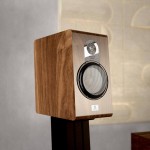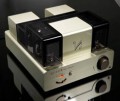
Editor's Choice Award 2009
John Marks: Luxman L505u integrated amplifier ($3700, April 2009). Luxman's entry-level but heavyweight integrated amplifier delivers sonic authority, tactility, centeredness, continuity, easefulness, soundstage size, image specificity—you name it—in spades. It's the difference between "This is pretty good" and "This is addictive."

The L-505 has been in continuous production for over thirty years and has quite often been Luxman's best selling single product. Of course it has been updated & refined many times over the past thirty years.
The L-505f was introduced in 2001 and was remarkably successful as many proud Luxman owners will happily testify. Its successor, the L-505u, now has Luxman's unique noise & distortion canceling technology - ODNF version 2.2 as well as the electronic input selector (trickle-down technology from the flagship C-1000f) , which has lowered channel crosstalk & increased channel separation..
The L-505u is a fully featured integrated amplifier, with a wonderful phono stage, multiple inputs (including one balanced), tone controls (easily defeated at the touch of a button), enough power to drive most speakers in just about any room in your home and a remote control to add convenience to a remarkably comprehensive integrated amplifier. It is a wonderful entrance to the world of Luxman.

Chassis bases have superb vibration absorption in order to supress noise levels. The power transformer, electrolytic capacitors and amplifer output stage (see amp block below) are laid out so as not to interefere with each other. To reduce intereference further, the block construction isolates each section using shielding panels, and extensive internal filtering to reject magnetic flux interference.

Luxman holds many patents for audio engineering, amongst them is the application of Global Negative Feedback to the output stage, which while widely used throughout the audio industry, they no longer use themselves.
Luxman nowadays use a distortion reduction circuit called Only Distortion Negative Feedback (ODNF). This system works by isolating noise & distortion at the output from the music signal and sparingly applying negative feedback to suppress them. Conventional negative feedback systems can have an adverse effect on the music, introducing phase distortion. "The circuit features such an ultra-wide range, ultra- high slew rate and ultra low distortion that it does not use phase compensation for the music signal amplifying circuits." This new technology also ensures that need for a DC servo circuit is alleviated, again improving sound quality.

Input Selector
Both the L-505u and L-509u, feature the new high quality electronic selector switch, which is the heart of the C-1000f pre-amp (one of Luxman’s 80th anniversary commemoration models). The sound quality deterioration using the new electronic input switch is now minimal, while channel separation and crosstalk efficiency were raised substantially in comparison with the previous L-505f / L-509f SE. In addition the illuminated position indicator around the input selector knob, makes it much easier to view the selected position even from afar.
Volume Control
The integrated amplifiers use a motorized APLS poteniometer.
Amplifier
The amplifier section has not been ignored either; noise and distortion has been kept to a minimum with the introduction of ODNF version 2.2. The deep, rich tone is well able to reveal subtle detail buried deep in the music, due to the removal of noise and distortion.
Pure Copper Cabling
Extensive listening was applied to the high purity, oxygen free copper (OFC) cables which are used to transmit the signal throughout the amplifier. These cables have a minimal audible signature and minimal electrical effect on the audio waveform. Linear wide bandwidth frequency response is achieved by the low measured values of both inductance and capacitance. The result, the cables do not color the sound, but pass it through, quickly.
Phono Pre Amplifier
Enjoy the ability to play or record your LP collection with the built-in phono stage which accommodates both Moving Magnet and Moving Coil cartridges. The MM input has approx. 35dB of gain. While the MC input has 55dB of gain (thats a multiplication of 550x). We recommend MC cartridges with an output >.7mV. Lower than that you might consider using the MT-88 moving coil step-up transformer. Click here to be redirected.
Subsonic Filter
A subsonic filter is also easily accessible on the front panel in order to remove unwanted low frequency noise while you are listening to a record. When the tylus hits the groove, you migt notice the woofers modulating in and out, evn though there is no music playing yet. This is due to the ultra low frequency information (below the music), this unnecessary information places a strain on the amplifier and is best filtered out. A mono switch is also available for both loudspeaker setup as well as mono record playback.
Headphone Amplifier
There is also a high quality headphone amplifier, accessible from the front panel. You can turn off the speaker output by a simple click of the Speaker Selector.
Two Pairs of Speaker Terminals
Large speaker terminals for driving two individual sets of speakers. At the turn of the speaker switch, it is possible to change between the two pairs of speakers easily. In addition, if the A+B function is used; Takasina capacitors are used to parallel the output which permits bi-wiring a single pair of speakers.
Power Meters
The large-sized power meters, calibrated in decibels are easy to read even from a distance. The logarithmic compression system is easy to grasp and also how this applies to the music. The meters are calibrated from -60dB below full rated power to +3dB above rated power. An 8mm thick acrylic covers the meters, which are normally backlit, though the illumination may be turned off from the remote control.
Remote Control
Easy to use, intelligently laid-out, aluminum remote control; all of the primary functions of the L-505u, including power on / off can be controlled from the comfort of your listening chair. Besides the electronic volume control, there is also a mute feature. The display meters’ back light can also be turned on / off from the remote control. see below

Tone Controls
The tone controls might seem like an anachronism in this day and age of minimalism, but they can be remarkably effective in bring to life a less than perfect music collection. We all have music gems in our collection that are sonicly challenging. A lot of the 1980's CDs are quite harsh sounding and the digital glare can be quite fatiguing. Reduce the treble slightly and while the harsh CD is not going to suddenly sound like a reference recording, at least it will now be perfectly listenable. Sit back relax, enjoy the music & forgot about the HiFi. When you want to bypass the tone controls, just engage the Line Straight switch.
NOTE: You might also use the Tone Controls for room acoustics’ correction. They are in effect simplified room equalization controls.
Line Phase Sensor
Here is a clever device found on the back of every Luxman powered product. You press the button and it will check the phase of the electricity it is receiving. If the AC outlet in the wall is incorrectly wired, meaning the live and neutral are swapped, a red LED will turn on to warn you. You only need to press it once, when you are installing a product to check that everything is in order. Its a simple mistake, that occurs often, and one that can seriously undermine your listening enjoyment.
AWARDS
STEREOPHILE (USA) - Editor's Choice Award (2009)
- Recommended Components; Class A (2009)
STEREOMOJO (USA) - Maximum Mojo
MJ TECHNOLOGY (Japan) - Technology Of The Year
AUDIO ACCESSORY (Japan) - Audio Excellence Award
STEREO (Japan) - Special Commendation
(October 2007)
John Marks reviewied the L-505u (along with the DU-50 universal player) for Stereophile, in the February 2010 issue. The following is an excerpt"Suffice it to say I think the Luxman L-505u is a screaming bargain.".. SPECIFICATIONS
|
Continuous effective output |
100W + 100W/8Ω |
||||||||||
|
Input |
4 line systems |
||||||||||
|
Sound recording input/output |
2 line systems |
||||||||||
|
Pre- output and main input |
1 system, each |
||||||||||
|
Speaker output |
A, B 2 systems |
||||||||||
|
Amplifier version |
ODNF 2.2 |
||||||||||
|
Output constitution |
Bipolar parallel PP |
||||||||||
|
Power transformer |
EI type 440VA |
||||||||||
|
Damping factor |
110 |
||||||||||
|
Harmonic Distortion |
|
||||||||||
|
Input sensitivity/impedance |
|
||||||||||
|
Output voltage Output Impedance /Damping Factor |
TAPE: 180mV and PRE-OUT: 1V 110 |
||||||||||
|
Signal-to-Noise Ratio (IHF-A) |
|
||||||||||
|
Frequency characteristic |
|
||||||||||
|
Controls |
|
||||||||||
|
Electric power consumption |
1.2W (stand-by), 82W (idle), 210W (rated output) |
||||||||||
|
Dimensions W x H x D |
18.3” (467mm) 7” (179) 17.25” (437) |
||||||||||
|
Weight |
46.2 lbs. (21kg) |


![[AVSHOW 2019] Huy Lan Anh mang đến AVSHOW 2 thương hiệu ultra Hi-end: MBL & Kharma](/media/news/120_206_1.jpg)











